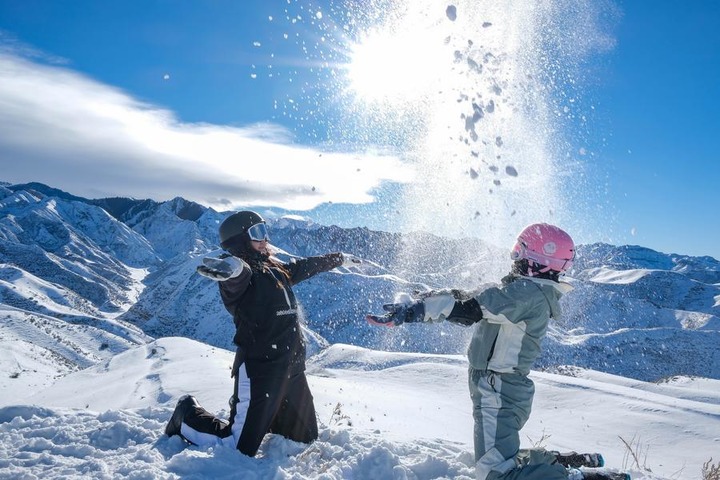
Tourists have fun at a ski resort in Fukang City, northwest China's Xinjiang Uygur Autonomous Region, Dec. 22, 2023. (Xinhua/Zhang Cheng)
BEIJING, Nov. 14 (Xinhua) -- Ski resorts across China are gradually opening as winter approaches, and a new upsurge of ice and snow sports is poised to take off.
The quicker popularization of ice and snow sports in China results in growing demand from consumers for sports clothing, equipment and others. From small items like ice skates and snowboards to big machines like snowmakers and groomers, innovative products are injecting new vitality into the industry.
China has recently released an ambitious plan to grow its ice and snow economy. With strong market demand and local supporting policies and measures, enterprises and industrial parks are accelerating their business deployment to fuel the ice and snow economy, experts say.
-- Technology propels product innovations
To embrace the upcoming snow season, newly launched automated production lines of ski boots are running at faster pace at the workshop of Dehong Ice and Snow Sports Technology Co., Ltd. in Liaoyuan City, northeast China's Jilin Province. With annual output expected to reach 300,000 pairs, the independently designed and developed ski boots are about to be shipped to nationwide skiing enthusiasts.
"We conduct research and development (R&D) on factors such as foot shapes and walking habits of the Asians for the regional market," General Manager Cao Guoqing said, noting that the enterprise is currently negotiating about cooperation with ski resorts and slopes.
Recent years see more technologies applied to the new products of ice and snow sports, with continuous innovation injecting vitality for the development of the ice and snow industry. New technologies such as 5G, AI and VR are constantly propelling industry growth.
The intelligent innersole captures data like foot pressure, motion acceleration and path during the skiing process; the warming snow sneakers containing flexible battery and elastic heating sheet that are able to provide warmth for 2.5 to 5 hours at -25℃...
In the meantime, technological breakthrough of materials, spares and components, as well as interdisciplinary and cross-sector integration are underway. For example, the Aerospace Research Institute of Material & Processing Technology, in collaboration with enterprises including China FAW Group, has applied aerospace advanced technologies of carbon fiber composite material and aerodynamic shape design to develop carbon fiber bobsleighs.
A product system comprising 15 categories of ice and snow equipment has taken shape in China, covering whole industry chains of equipment from head to toe, from individual to venue, and from competition to mass sports, according to a recent routine policy briefing by the State Council Information Office. The number of manufacturers rose from approximately 300 in 2015 to around 900 in 2023, it said, noting that there are currently 21 SRDI (specialized, refinement, differentiated and innovation) enterprises for ice and snow equipment.
-- Big plan and solid policies support industry development
China has recently released an ambitious plan to grow its ice and snow economy, targeting winter sports, tourism, and equipment manufacturing as key drivers of economic growth, with a projected value of 1.5 trillion yuan by 2030.
"The winter season is coming, and local governments are eager to seize the opportunity," said Fu Baosen, a professor at Shenyang Sport University.
In fact, a slew of policies and measures are already in place to speed up the development of the ice and snow industry. The Ministry of Industry and Information Technology (MIIT) has set up a work group on industrial standardization to study the standards on equipment for ice and snow arenas while transform applicable international standards.
At the Zhangjiakou high-tech zone, the ice and snow thematic fund provides financing support to equipment manufacturers, while the ice and snow equipment industrial park promotes scale-up and clustering industrial development with the equipment and appliances made by the local manufacturers having been applied in a dozen of large ski resorts and national projects.
Other provinces and regions such as Jilin and Heilongjiang have also developed industrial clusters in line with local conditions.
One of the most critical aspects of the plan is its emphasis on a "full industry chain," according to Wang Xueli, a professor at Tsinghua University. The policy aims to foster integration across winter sports, tourism, equipment manufacturing, and cultural promotion, treating these elements as an interconnected industry. "It includes everything from manufacturing to services," Wang noted.
The plan also highlights financial support, increasing credit access for winter sports companies and encouraging qualifying businesses to go public.
Hao Lishun, head of an equipment industry department of MIIT said that the ministry will study and publish measures on promoting the high-quality development of sports equipment including ice and snow sports equipment, further optimize business environment, propel the growth of SRDI equipment manufacturers, and encourage the collaborative efforts of enterprises, universities, research institutes and users on strengthening breakthrough of key technologies and R&D of innovative products.
It is noted that the General Administration of Sport will expand the supply of ice and snow products and services to mass people, enhance the support to application of new products, materials and technologies, and build new scenarios of ice and snow sports for public engagement. (Edited by Niu Huizhe with Xinhua Silk Road, niuhuizhe@xinhua.org)




 A single purchase
A single purchase









